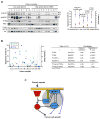PTEN, NHERF1 and PHLPP form a tumor suppressor network that is disabled in glioblastoma
- PMID: 21804599
- PMCID: PMC3208076
- DOI: 10.1038/onc.2011.324
PTEN, NHERF1 and PHLPP form a tumor suppressor network that is disabled in glioblastoma
Abstract
The phosphatidylinositol-3-OH kinase (PI3K)-Akt pathway is activated in cancer by genetic or epigenetic events and efforts are under way to develop targeted therapies. phosphatase and tensin homolog deleted on chromosome 10 (PTEN) tumor suppressor is the major brake of the pathway and a common target for inactivation in glioblastoma, one of the most aggressive and therapy-resistant cancers. To achieve potent inhibition of the PI3K-Akt pathway in glioblastoma, we need to understand its mechanism of activation by investigating the interplay between its regulators. We show here that PTEN modulates the PI3K-Akt pathway in glioblastoma within a tumor suppressor network that includes Na(+)/H(+) exchanger regulatory factor 1 (NHERF1) and pleckstrin-homology domain leucine-rich repeat protein phosphatases 1 (PHLPP1). The NHERF1 adaptor, previously characterized by our group as a PTEN ligand and regulator, shows also PTEN-independent Akt-modulating effects that led us to identify the PHLPP1/PHLPP2 Akt phosphatases as NHERF1 ligands. NHERF1 interacts via its PDZ domains with PHLPP1/PHLPP2 and scaffolds heterotrimeric complexes with PTEN. Functionally, PHLPP1 requires NHERF1 for membrane localization and growth-suppressive effects. PHLPP1 loss boosts Akt phosphorylation only in PTEN-negative cells and cooperates with PTEN loss for tumor growth. In a panel of low-grade and high-grade glioma patient samples, we show for the first time a significant disruption of all three members of the PTEN-NHERF1-PHLPP1 tumor suppressor network in high-grade tumors, correlating with Akt activation and patient's abysmal survival. We thus propose a PTEN-NHERF1-PHLPP PI3K-Akt pathway inhibitory network that relies on molecular interactions and can undergo parallel synergistic hits in glioblastoma.
Conflict of interest statement
The authors have no competing financial interests in relation to this work.
Figures





References
-
- Alessi DR, Kozlowski MT, Weng QP, Morrice N, Avruch J. 3-Phosphoinositide-dependent protein kinase 1 (PDK1) phosphorylates and activates the p70 S6 kinase in vivo and in vitro. Curr Biol. 1998;8:69–81. - PubMed
-
- Brognard J, Sierecki E, Gao T, Newton AC. PHLPP and a second isoform, PHLPP2, differentially attenuate the amplitude of Akt signaling by regulating distinct Akt isoforms. Mol Cell. 2007;25:917–31. - PubMed
Publication types
MeSH terms
Substances
Grants and funding
LinkOut - more resources
Full Text Sources
Medical
Molecular Biology Databases
Research Materials
Miscellaneous

